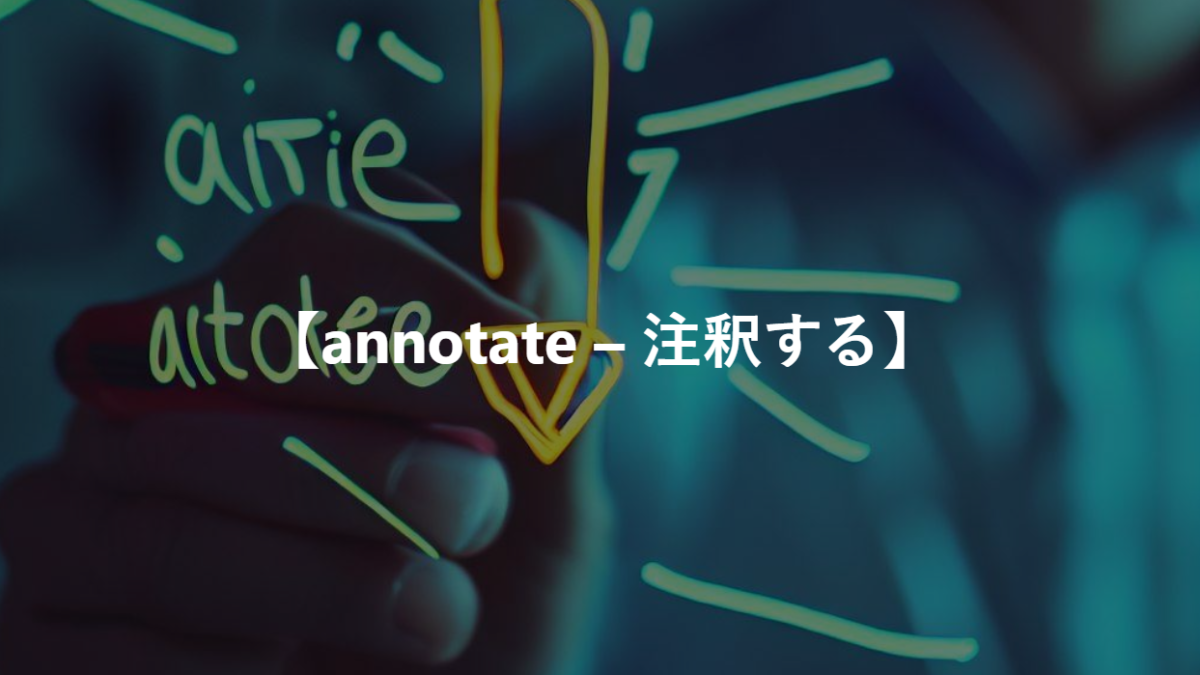語源・類義語・反対語・例文
【Annotate – 注釈する】という単語の語源とか由来を知っていますか?
「Annotate」(注釈する)という単語は、ラテン語の「annotatus」、これは「annotare」という動詞の過去分詞形から来ています。「annotare」自体は、「ad-」(〜へ)と「notare」(印をつける、記録する)から構成されており、「何かに対して注意を加える」または「詳細を記録する」ことを意味します。「notare」は「nota」という単語に関連しており、「nota」は「印」や「記号」を意味します。したがって、「annotate」は本来、「テキストや文書に注釈を加える」、「重要なポイントに印をつける」などの意味で使われるようになりました。時間が経つにつれ、この単語は一般的に「テキストに説明的な注釈を加える」という意味で使われるようになり、学術的な文献やデジタルメディアの文脈で頻繁に使用されています。
The word “annotate” comes from the Latin “annotatus,” the past participle form of “annotare.” “Annotare” itself is composed of “ad-” (to) and “notare” (to mark, to note), meaning “to add notes to something” or “to record details.” “Notare” is related to the word “nota,” which means “mark” or “sign.” Therefore, “annotate” originally meant “to add notes or comments to a text or document” or “to mark important points.” Over time, the word has come to be used more generally to mean “to add explanatory notes to a text,” and it is frequently used in the context of academic literature or digital media.
この単語の類義語・反対語を教えてください。
類義語
- Comment: コメントする。テキストに対する意見や説明を加える行為。
- Gloss: 注釈を加える。特に古文書や外国語のテキストに対して、語句の意味を説明するために用いられる。
- Explain: 説明する。テキストや現象の意味や背景を明らかにする。
- Elucidate: 明らかにする。複雑なテキストやアイデアをより理解しやすくするために詳細を加える。
- Explicate: 詳述する。テキストの意味や構造を詳細に説明する。
反対語
- Obscure: 不明瞭にする。テキストや意味をより分かりにくくする。
- Confuse: 混乱させる。テキストに対する理解を難しくする。
- Complicate: 複雑にする。シンプルなテキストやアイデアに不必要な詳細を加えて理解を困難にする。
- Mystify: 神秘化する。テキストの意味を意図的に隠したり、理解しづらくする。
- Conceal: 隠す。テキストの重要な部分や意味を明らかにせずに覆い隠す。
この単語に似た単語で間違いやすい単語はありますか?
Note: 一般的には「注意する」や「メモする」という意味で、情報や観察を簡潔に記録する行為を指します。「note」は「annotate」と比べてより広範な用途を持ち、学術的な文脈だけでなく、日常生活での観察や考えの簡単な記録にも使われます。
この単語を使った例文を5つほど教えてください。
The student annotated the textbook with additional notes for better comprehension.
(学生はテキストに追加の注釈を付けて、より理解しやすくしました。)
The researcher annotated the survey results to provide detailed explanations of the data.
(研究者は調査結果に注釈を付けて、データの詳細な説明を提供しました。)
The editor’s task is to read through the manuscript and annotate any grammatical errors or inconsistencies.
(編集者の役割は原稿を読みながら、文法の誤りや矛盾を注釈することです。)
The professor asked the students to annotate the assigned reading with their own reflections and questions.
(教授は学生に割り当てられた読書に自分自身の考察や質問を注釈するように求めました。)
The digital document allows users to highlight and annotate important sections for future reference.
(デジタルドキュメントでは、重要な部分を強調表示し、将来の参照のために注釈することができます。)
【annotate – 注釈する】のコロケーション
- Annotate a text: テキストに注釈を加える。本、論文、記事などの文書に対して、読み手が理解を深めるための補足情報や説明を書き加える行為です。
- Annotate a manuscript: 原稿に注釈を加える。特に出版前の原稿に対して、編集者や校閲者が修正提案や説明を記入する場合に使われます。
- Annotate a diagram: 図表に注釈を加える。図やグラフに追加情報や説明を付け、データの解釈を助ける行為です。
- Annotate data: データに注釈を加える。データセットに対して、特定の情報やタグを付けて、その後の分析や検索を容易にするプロセスです。特にコンピュータサイエンスや機械学習の分野でよく用いられます。
- Annotate a map: 地図に注釈を加える。地図上に追加情報を記入して、地理的な特徴やデータを明確にする行為です。
「annotate」は、テキストやデータに価値を追加する行為を指します。これは、情報の理解を深めたり、特定のコンテキストでの使用を容易にしたりするために行われます。以下に示すコロケーションは、「annotate」がどのように利用されるかについての洞察を提供します。
最初に、Annotate a textは、文学作品や学術論文、記事など、あらゆる種類のテキストに対して補足情報や説明を加えることを意味します。このプロセスを通じて、読者はテキストの理解を深め、より豊かな読書体験を得ることができます。
Annotate a manuscriptは、出版前の原稿に対して、編集者や校閲者がコメントや修正提案を行うことです。これにより、作品の質を高め、より読みやすい内容に改善することが目指されます。
Annotate a diagramでは、図表やグラフに注釈を加えて、その情報を明確にし、データの解釈を支援します。これは、学術的なプレゼンテーションやレポート作成において特に重要です。
Annotate dataは、データセットにラベルやタグを付けて、後の分析や検索を容易にする行為を指します。このプロセスは、特に機械学習やデータサイエンスの分野で価値があります。
最後に、Annotate a mapは、地図上に追加情報を記入することで、地理的な特徴や関連するデータをユーザーに提供します。これにより、地図の有用性が高まり、特定の場所に関する理解が深まります。
これらのコロケーションは、「annotate」が情報の提供、理解の促進、そして知識の共有にどのように貢献するかを示しています。各コロケーションは、「annotate」の用途の多様性と、様々な分野でのその重要性を強調しています。
The term “annotate” refers to the act of adding value to texts or data. This is done to deepen understanding or to facilitate usage in specific contexts. The collocations listed below provide insight into how “annotate” is utilized.
Firstly, Annotate a text means adding supplementary information or explanations to any kind of text, such as literary works, academic papers, or articles. Through this process, readers can deepen their understanding and enjoy a richer reading experience.
Annotate a manuscript involves editors or proofreaders adding comments or suggestions for revision to pre-published manuscripts. The goal is to enhance the quality of the work and improve its readability.
Annotate a diagram refers to the addition of notes to diagrams or graphs to clarify the information they contain and assist in interpreting the data. This is particularly important in academic presentations or report writing.
Annotate data signifies labeling or tagging datasets to facilitate further analysis or searches. This process is especially valuable in fields like machine learning and data science.
Lastly, Annotate a map involves inserting additional information onto a map to provide users with geographic features or related data. This enhances the utility of the map and deepens understanding of specific locations.
These collocations demonstrate how “annotate” contributes to providing information, promoting understanding, and sharing knowledge. Each collocation highlights the versatility of “annotate” and its importance across various fields.
文法問題
問題1
Choose the correct word to complete the sentence.
“The student was asked to __ the textbook to provide additional insights for the class.”
- A) annotate
- B) announce
- C) allocate
- D) analyze
正解: A) annotate
解説: 文脈から判断して、「注釈する」という意味の動詞が必要です。選択肢Aの「annotate」が最適です。
問題2
Select the word that best fits the sentence.
“In her research paper, she needed to __ her sources to help readers understand the context.”
- A) annotate
- B) advertise
- C) abolish
- D) amplify
正解: A) annotate
解説: 文の文脈から、ここでは「注釈する」という意味の動詞が最適です。選択肢Aの「annotate」が適切です。
問題3
Fill in the blank with the appropriate word.
“The professor encouraged the students to __ their notes to make studying easier.”
- A) activate
- B) annotate
- C) anticipate
- D) allocate
正解: B) annotate
解説: 文脈から、ここでは「注釈する」という意味の動詞が必要です。選択肢Bの「annotate」が最も適しています。
問題4
Complete the sentence with the correct word.
“To help future readers, the editor decided to __ the manuscript with detailed comments.”
- A) allocate
- B) amplify
- C) annotate
- D) analyze
正解: C) annotate
解説: 文脈から、ここでは「注釈する」という意味の動詞が最適です。選択肢Cの「annotate」が適切です。
問題5
Choose the best word to fill in the blank.
“During the lecture, the teacher would often __ the slides with additional information to clarify complex points.”
- A) animate
- B) annotate
- C) anticipate
- D) allocate
正解: B) annotate
解説: 文の文脈から、ここでは「注釈する」という意味の動詞が必要です。選択肢Bの「annotate」が最適です。

